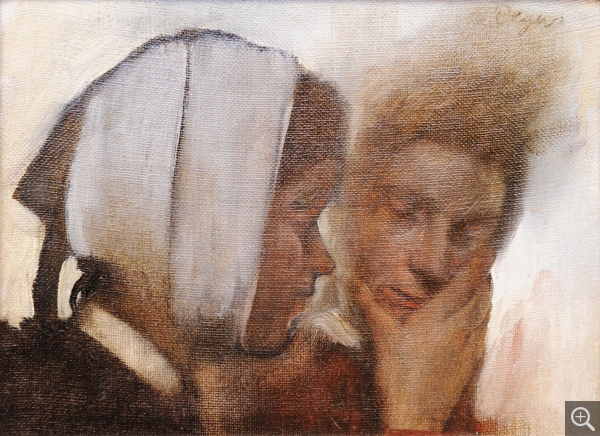Impressionism
English
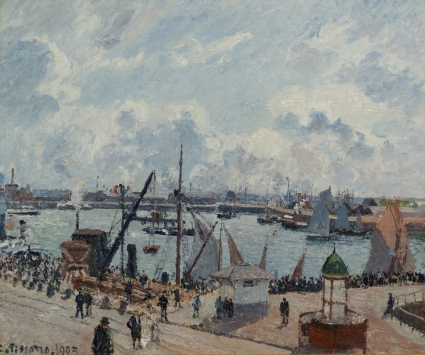
Camille PISSARRO (1831-1903)
The Outer Harbour of Le Havre, Morning, Sun, Rising Tide
1903
oil on canvas
54.5 x 65 cm
© MuMa Le Havre / David Fogel
The Outer Harbour of Le Havre, Morning, Sun, Rising Tide
1903
oil on canvas
54.5 x 65 cm
© MuMa Le Havre / David Fogel
HD image
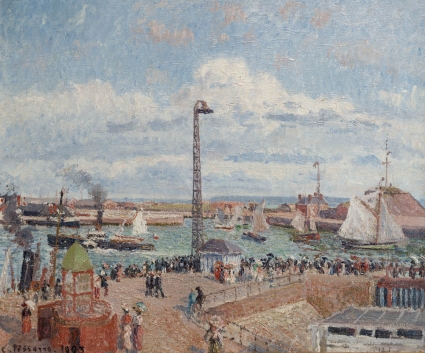
Camille PISSARRO (1831-1903)
Pilots' Jetty
1903
oil on canvas
54.5 x 65.3 cm
© MuMa Le Havre / David Fogel
Pilots' Jetty
1903
oil on canvas
54.5 x 65.3 cm
© MuMa Le Havre / David Fogel
HD image
Painted in Le Havre, these are two of the final artworks executed by Camille Pissarro (1830–1903), a few months prior to his death. The artist returned to the harbour where he had arrived as a child from the island of St Thomas in the West Indies. Finding himself in a delicate financial position in the spring of 1903, Pissarro was forced to cater to the tastes of collectors. He accepted an invitation from the collector Pieter van de Velde, based in Le Havre, who wanted him to paint a series depicting the rapidly changing outer harbour. The artist settled into the Continental hotel, which afforded him a stunning view over the entrance to the harbour, and chose the jetty as his motif, for he felt that it was an area of Le Havre "of which the people of the town are proud".
Part of a set of around twenty canvases, the two paintings at MuMa are representative of the final phase of his work. A founding member of Impressionism, Pissarro was drawn in 1886 to the scientific theories of the Neo-Impressionists like Signac and Seurat. After an entire series of works in which he broke down colours into small juxtaposed dabs, using the pointillist technique, he returned in 1890 to his old manner of painting, but with renewed subjects. In addition to the rural motifs that characterized his previous works, he began producing city and harbour scenes. The paintings portraying harbour basin activity in Le Havre are similar to a prolific series on the bustling streets and quays of Paris, Rouen and Dieppe.
At Le Havre, as with most of the works from this period, Pissarro adopted an elevated point of view, a high vantage point that had the advantage of protecting his fragile eyes from the dust that tended to irritate them. Between July and September 1903, he was able to paint three different series of the outer harbour from his window. While the motif of the information pillar appears in both MuMa paintings, one reveals to the east a section of the Grand Quai furrowed by tramway tracks, while the other, facing west, shows part of the old jetty with the pilot station in the foreground. All of the paintings in the series are variations on these two points of view, shifted more toward either the city or the water.
The composition of the two paintings is strongly structured by the slanted lines of the edges of the basins and the vertical lines of the streetlamps, masts and ship funnels. With these electrical installations, cranes and steamers, Pissarro gives us a decidedly modern view of the harbour of Le Havre. He captures the onlookers in full motion giving the scene the feel of a snapshot. The motifs, bluntly cut by the edges of the painting, also call to mind the photographic images that fascinated so many painters at the time.
On August 29, 1903, when Pissarro expressed to his son Lucien his disappointment in the art collectors of Le Havre who were "still concerned with Salon painting", he must have ignored the fact that Olivier Senn had acquired two of his works in 1900, and that the collectors Van der Velde, Dussueil and Metz had each purchased a canvas from the series. Although the artist berated the ignorance of the museum's purchasing commission, this was the first transaction he negotiated directly with such an institution. Pissarro nevertheless acknowledged the beginnings of a change. With this double acquisition, the city of Le Havre became the first French municipality to enrich the collection of its museum with the works of Pissarro.
Part of a set of around twenty canvases, the two paintings at MuMa are representative of the final phase of his work. A founding member of Impressionism, Pissarro was drawn in 1886 to the scientific theories of the Neo-Impressionists like Signac and Seurat. After an entire series of works in which he broke down colours into small juxtaposed dabs, using the pointillist technique, he returned in 1890 to his old manner of painting, but with renewed subjects. In addition to the rural motifs that characterized his previous works, he began producing city and harbour scenes. The paintings portraying harbour basin activity in Le Havre are similar to a prolific series on the bustling streets and quays of Paris, Rouen and Dieppe.
At Le Havre, as with most of the works from this period, Pissarro adopted an elevated point of view, a high vantage point that had the advantage of protecting his fragile eyes from the dust that tended to irritate them. Between July and September 1903, he was able to paint three different series of the outer harbour from his window. While the motif of the information pillar appears in both MuMa paintings, one reveals to the east a section of the Grand Quai furrowed by tramway tracks, while the other, facing west, shows part of the old jetty with the pilot station in the foreground. All of the paintings in the series are variations on these two points of view, shifted more toward either the city or the water.
The composition of the two paintings is strongly structured by the slanted lines of the edges of the basins and the vertical lines of the streetlamps, masts and ship funnels. With these electrical installations, cranes and steamers, Pissarro gives us a decidedly modern view of the harbour of Le Havre. He captures the onlookers in full motion giving the scene the feel of a snapshot. The motifs, bluntly cut by the edges of the painting, also call to mind the photographic images that fascinated so many painters at the time.
On August 29, 1903, when Pissarro expressed to his son Lucien his disappointment in the art collectors of Le Havre who were "still concerned with Salon painting", he must have ignored the fact that Olivier Senn had acquired two of his works in 1900, and that the collectors Van der Velde, Dussueil and Metz had each purchased a canvas from the series. Although the artist berated the ignorance of the museum's purchasing commission, this was the first transaction he negotiated directly with such an institution. Pissarro nevertheless acknowledged the beginnings of a change. With this double acquisition, the city of Le Havre became the first French municipality to enrich the collection of its museum with the works of Pissarro.
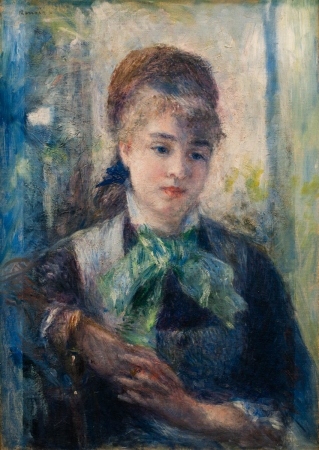
Pierre-Auguste RENOIR (1841-1919)
Portrait of Nini Lopez
1876
oil on canvas
54 x 39 cm
© MuMa Le Havre / David Fogel
Portrait of Nini Lopez
1876
oil on canvas
54 x 39 cm
© MuMa Le Havre / David Fogel
HD image
Nini Lopez first appeared in the work of Auguste Renoir (1841–1919) in La Loge (The Theatre Box), painted in 1874. The young woman from Montmartre, cruelly nicknamed Nini-Gueule-de-Raie, or "fish face", is shown alongside the artist's brother. Although the artwork was immediately purchased by the art dealer "le Père Martin", Renoir, like many of his Impressionist friends, was experiencing serious financial difficulty at the time. In the spring of 1875, he moved into a new studio on rue Cortot in Montmartre. The painter liked the almost wild quality of the garden, where Nini posed for him regularly. Known for being serious and punctual, the young woman become the artist's favourite model between 1875 and 1879, appearing in at least fourteen paintings.
The Portrait of Nini Lopez was painted in 1876, the year the artist outshone himself in breathtaking compositions such as The Swing or Dance at Le Moulin de la Galette. But at the time, Renoir was also painting numerous intimate scenes and smaller portraits for commercial purposes. The canvas purchased by collector Olivier Senn from Le Havre is very similar to a smaller work, Portrait of Nini Lopez (Blond Profile), in which the young woman is dressed in the same clothes: black and white bodice, green scarf and black ribbon tying back her hair. The model has the same soft features that give Nini her dreamy charm.
The painting, which places great emphasis on the study of light behind the model, was undoubtedly executed near one of the windows that opened onto the garden of the studio on rue Cortot. Renoir was striving to convey the changing reflections of light on the human figure.
A study conducted by C2RMF, the centre for the research and restoration of French museums, revealed that Renoir had taken a canvas already painted—a horizontal landscape—and turned it vertically before enlarging it with two bands. The artwork shows traces of this story—thick brushstrokes underlying the woman's face, an almost sketch-like treatment of the side edges—, and the ensuing freedom of execution lends an extraordinary modern quality to the work as a whole.
In 1877, as Renoir's talent as a portrait artist earned him prestigious commissions with the bourgeoisie, Nini disappeared from his painting following her marriage to a third-rate actor in the Montmartre theatre, much to the dismay of her mother and the artist, who had become her protector, for they had both dreamed of a bourgeois marriage for her. But during the six years she posed for the artist, the young Nini incarnated Renoir's feminine ideal, filled with happiness and joy of life.
The Portrait of Nini Lopez was painted in 1876, the year the artist outshone himself in breathtaking compositions such as The Swing or Dance at Le Moulin de la Galette. But at the time, Renoir was also painting numerous intimate scenes and smaller portraits for commercial purposes. The canvas purchased by collector Olivier Senn from Le Havre is very similar to a smaller work, Portrait of Nini Lopez (Blond Profile), in which the young woman is dressed in the same clothes: black and white bodice, green scarf and black ribbon tying back her hair. The model has the same soft features that give Nini her dreamy charm.
The painting, which places great emphasis on the study of light behind the model, was undoubtedly executed near one of the windows that opened onto the garden of the studio on rue Cortot. Renoir was striving to convey the changing reflections of light on the human figure.
A study conducted by C2RMF, the centre for the research and restoration of French museums, revealed that Renoir had taken a canvas already painted—a horizontal landscape—and turned it vertically before enlarging it with two bands. The artwork shows traces of this story—thick brushstrokes underlying the woman's face, an almost sketch-like treatment of the side edges—, and the ensuing freedom of execution lends an extraordinary modern quality to the work as a whole.
In 1877, as Renoir's talent as a portrait artist earned him prestigious commissions with the bourgeoisie, Nini disappeared from his painting following her marriage to a third-rate actor in the Montmartre theatre, much to the dismay of her mother and the artist, who had become her protector, for they had both dreamed of a bourgeois marriage for her. But during the six years she posed for the artist, the young Nini incarnated Renoir's feminine ideal, filled with happiness and joy of life.
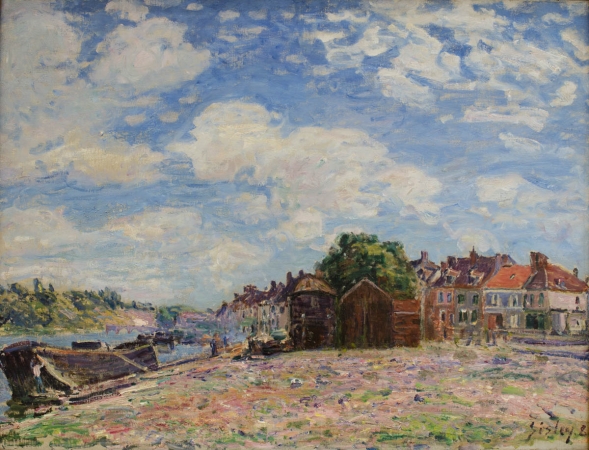
Alfred SISLEY (1839-1899)
The Loing at Saint-Mammès
1885
oil on canvas
55 x 73.2 cm
© MuMa Le Havre / David Fogel
The Loing at Saint-Mammès
1885
oil on canvas
55 x 73.2 cm
© MuMa Le Havre / David Fogel
HD image
Born in Paris to an English family, Alfred Sisley (1839–1899) was sent to the United Kingdom when he was eighteen. There is where he discovered, prior to the Impressionists, the work of Turner, who was widely exhibited in London, and the work of Constable, another undisputed master of the English landscape. Continuing financial difficulties quickly brought him back to the Paris area, first to Louveciennes, then Marly. After 1880, he settled in the Moret-sur-Loing area, where he remained until his death.
From 1882 to 1885, Sisley explored the banks of the Loing. Between Moret, a medieval town in the countryside, and Saint-Mammès, renowned for its shipbuilding and traditional trades, Sisley worked from a wide range of vantage points. In 1885, the group of houses near the locks caught his attention and provided him with the motif for a set of compositions akin to a series. Sisley systematically surveyed the area, making sketches in his notebooks and recording technical details. Despite the ambiguity of the title—The Loing at Saint-Mammès—, Sisley seems to have positioned himself at the exact confluence of the river and the Seine, on the bank of the Loing, his gaze sweeping over the river and the tiny town.
The main protagonist in this landscape, the sky absorbs two thirds of the composition. Like Constable when he conducted a systematic study of cloud types, Sisley attributed an "architectural" role to the sky, using different planes to give his painting depth. In the majestic "foreground" of the bank, a genuine space of pure abstraction, the artist casts the shadow of the clouds in free and energetic touches, as if on a colour palette. Each plane is given its own characteristic touch: the lively and sumptuous brushstrokes of the bank, the structured colour blocks of the houses, the vibrant lightness of the plants, and the transparency of the sky.
In the 1880s, Sisley, like the Impressionists, pondered the inherent properties of colour. His answer was to accentuate each shade and develop a colour range later found in 1897 in his coastal views of Wales.
From 1882 to 1885, Sisley explored the banks of the Loing. Between Moret, a medieval town in the countryside, and Saint-Mammès, renowned for its shipbuilding and traditional trades, Sisley worked from a wide range of vantage points. In 1885, the group of houses near the locks caught his attention and provided him with the motif for a set of compositions akin to a series. Sisley systematically surveyed the area, making sketches in his notebooks and recording technical details. Despite the ambiguity of the title—The Loing at Saint-Mammès—, Sisley seems to have positioned himself at the exact confluence of the river and the Seine, on the bank of the Loing, his gaze sweeping over the river and the tiny town.
The main protagonist in this landscape, the sky absorbs two thirds of the composition. Like Constable when he conducted a systematic study of cloud types, Sisley attributed an "architectural" role to the sky, using different planes to give his painting depth. In the majestic "foreground" of the bank, a genuine space of pure abstraction, the artist casts the shadow of the clouds in free and energetic touches, as if on a colour palette. Each plane is given its own characteristic touch: the lively and sumptuous brushstrokes of the bank, the structured colour blocks of the houses, the vibrant lightness of the plants, and the transparency of the sky.
In the 1880s, Sisley, like the Impressionists, pondered the inherent properties of colour. His answer was to accentuate each shade and develop a colour range later found in 1897 in his coastal views of Wales.
Edgar DEGAS (1834-1917)
Washerwomen
ca. 1870-1872
oil on canvas
15 x 21 cm
© Ministère de la Culture et de la Communication / Didier Plowy
Washerwomen
ca. 1870-1872
oil on canvas
15 x 21 cm
© Ministère de la Culture et de la Communication / Didier Plowy
Two days following its inauguration by André Malraux, the Musée-maison de la culture du Havre received, on loan from the State by the Order of June 26, 1961, the small painting by Degas Washerwomen, along with four other artworks. A move that demonstrated the French Ministry of Culture's interest in the brand new establishment. The work was unfortunately stolen in 1973, only to reappear on the New York art market thirty-seven years later. Officially restored to France by the American authorities, it was once again entrusted to the Le Havre museum by the Musée d'Orsay, and resumed its place on the walls of the Musée d'art moderne André Malraux the year of its fiftieth anniversary celebration.
This little painting is shrouded in double the mystery. Firstly, the period during which it had disappeared from the public domain remains and will undoubtedly remain fraught with secrets. But above all, due to this lengthy interruption, it was not included in the review that art historians have made of Degas' work over the past twenty years.
The painting is listed in Paul André Lemoisne's catalogue raisonné on the work of Degas as Washerwomen, or Washerwomen with toothaches. Very different from the series of "Women Ironing" and the "Washerwomen" that the artist presented at the second Impressionist exhibition in 1876, or the later series on women exhausted by their work, the painting deposited at MuMa does not likely portray women at work, and even less women suffering from toothaches, as the woman holding her cheek might imply.
So then who are these women? What is their connection? What are they doing? Their lowered eyes, focused on something hidden by a deliberately tight frame, seems to bring them together, without allowing us to guess what captivates them. The woman facing us (and can we be sure she is a woman, for that matter?) appears motionless, attentive to what the other, undoubtedly younger, woman is doing. Everything, in her slightly tilted face, concentrated and filled with restraint, seems to indicate studious application, modesty... is she a younger sister, a student? What is the young woman wearing? A headdress? Rather than a bandage?
The only conclusions provided by the scientific examination are that this is the original size, so the painting is not a fragment cut from a larger work, and that there is no underlying drawing.
So is this a simple head study, done in quick brushstrokes, or the sketch of a more elaborate project? Perhaps this small painting will reveal its secrets through new comparisons with other works by Degas or with the discovery of new documents that shed light on the master's life and work.
This little painting is shrouded in double the mystery. Firstly, the period during which it had disappeared from the public domain remains and will undoubtedly remain fraught with secrets. But above all, due to this lengthy interruption, it was not included in the review that art historians have made of Degas' work over the past twenty years.
The painting is listed in Paul André Lemoisne's catalogue raisonné on the work of Degas as Washerwomen, or Washerwomen with toothaches. Very different from the series of "Women Ironing" and the "Washerwomen" that the artist presented at the second Impressionist exhibition in 1876, or the later series on women exhausted by their work, the painting deposited at MuMa does not likely portray women at work, and even less women suffering from toothaches, as the woman holding her cheek might imply.
So then who are these women? What is their connection? What are they doing? Their lowered eyes, focused on something hidden by a deliberately tight frame, seems to bring them together, without allowing us to guess what captivates them. The woman facing us (and can we be sure she is a woman, for that matter?) appears motionless, attentive to what the other, undoubtedly younger, woman is doing. Everything, in her slightly tilted face, concentrated and filled with restraint, seems to indicate studious application, modesty... is she a younger sister, a student? What is the young woman wearing? A headdress? Rather than a bandage?
The only conclusions provided by the scientific examination are that this is the original size, so the painting is not a fragment cut from a larger work, and that there is no underlying drawing.
So is this a simple head study, done in quick brushstrokes, or the sketch of a more elaborate project? Perhaps this small painting will reveal its secrets through new comparisons with other works by Degas or with the discovery of new documents that shed light on the master's life and work.
Pages
- « first
- ‹ previous
- 1
- 2
- 3

























